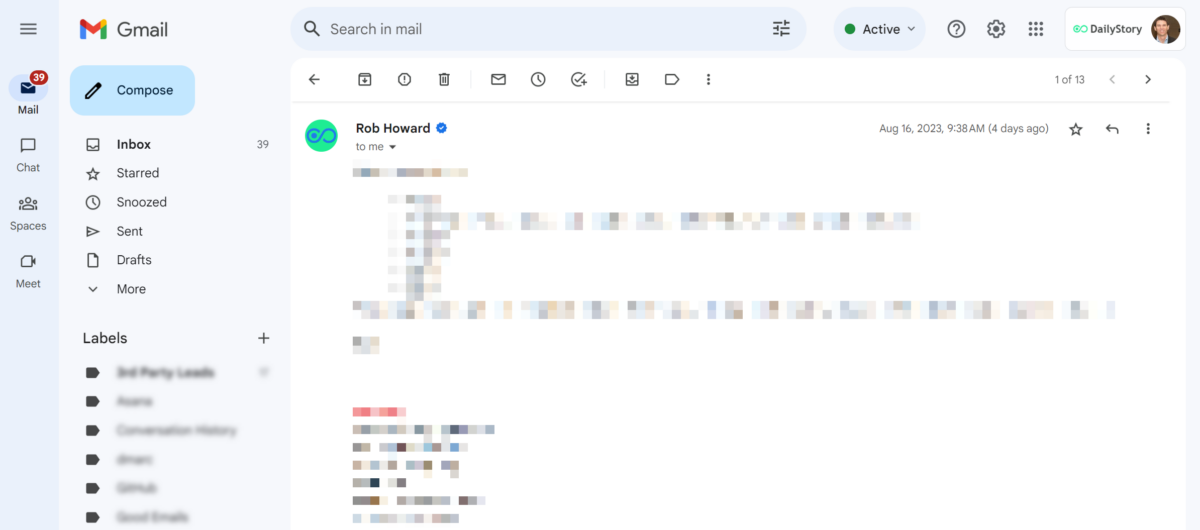You might have received an email recently that looked like this:

This email contains a branded logo as well as Google’s verified checkmark.
After a little bit of research you ended up here and are wondering what this is, how you get it, and, most importantly: how it impacts email deliverability.
What is Google’s Verified Checkmark
Starting from May 3rd, 2023, Google introduced verified checkmarks in Gmail.
These checkmarks appear next to sender names and help users distinguish genuine senders from impersonators.
In 2021, Google introduced Brand Indicators for Message Identification (BIMI) in Gmail. This feature requires senders to use their brand logo, showing it as an avatar in emails. And now, users will see a checkmark icon for senders who use BIMI, making it easier to spot real messages from fake ones.
But getting the Google Verified Blue Checkmark isn’t so simple.
What you’ll pay for the Google Verified Checkmark
If you want the Google Checkmark, be ready to spend $1,200 – $1,400 per-year.
Setting up your brand’s logo using BIMI (a TXT record added to your DNS) doesn’t require a VMC. But if you want Google’s Verified Blue Checkmark you’ll have to buy a VMC. And currently there are only 2 vendors selling VMC certificates: DigiCert and Entrust.
You may be wondering if this is a waste of budget? The blue checkmark next to your logo would be nice, but is it worth thousands of dollars a year?
The impact on email deliverability
There is very minimal impact on email deliverability by registering your brand for deliverability.
BIMI is another feature, in addition to DMARC, DKIM & SPF, intended to improve security.
However, unlike BIMI, DMARC, DKIM & SPF records do have a direct impact on deliverability. And these are considered the baseline to get correct. If setup incorrectly or missing altogether, they will harm your deliverability due to authentication failures.
Let’s briefly look at what these security features are.
Email security features
Strong security boosts recipients’ confidence in your intended emails, helping them distinguish you from other senders. And this tends to mean that you get the deliverability you deserve rather than the deliverability of another sender, because the recipient can more easily differentiate you.
Sender Policy Framework (SPF) – SPF shows that the owner of the return-path domain has authorized the IPs in the SPF record, making it harder for a bad guy to pretend to be your email server.
This confirms that the IP address sending the email is allowed to send emails for that domain. Setting up SPF is required when using DailyStory’s email marketing platform.
DomainKeys Identified Mail (DKIM) – DKIM shows that the email has not been tampered with and that the “d=“ domain owner has authorized the email, making it harder for a bad guy to intercept the email and inject spam or malware.
Setting up DKIM is required when using DailyStory’s email marketing platform.
Domain-based Message Authentication Reporting & Conformance (DMARC) – DMARC allows the From domain owner to assert that they are only sending email that has matching DKIM or SPF, making it harder for a bad guy to use that From domain.
Setting up DMARC is not required when using DailyStory’s email marketing platform, but it is recommended.
Brand Indicators for Message Identification (BIMI) – BIMI allows the From domain owner to display their trademarked image to the user before they open the email, making it harder for a bad guy to trick a user into opening an email from a fraudulent “similar” domain (chasebank.com vs chase-banking.us).
Verified Mark Certificate (VMC) – A Verified Mark Certificate (VMC) is a digital certificate issued by a certificate authority that verifies logo ownership. Your logo must be a registered trademark before receiving a VMC. A VMC verifies that your organization is the legal owner of your brand logo.
Is the Google Verified Checkmark worth it
No, it’s not something we currently recommend to our customers or feel it is necessary for them to use. And, it is currently cost prohibitive for most businesses and organizations.
Instead we recommend following these recommendations for email deliverability.
If you do want to setup your BIMI records for Google’s Verified Checkmark you can find more details here.

